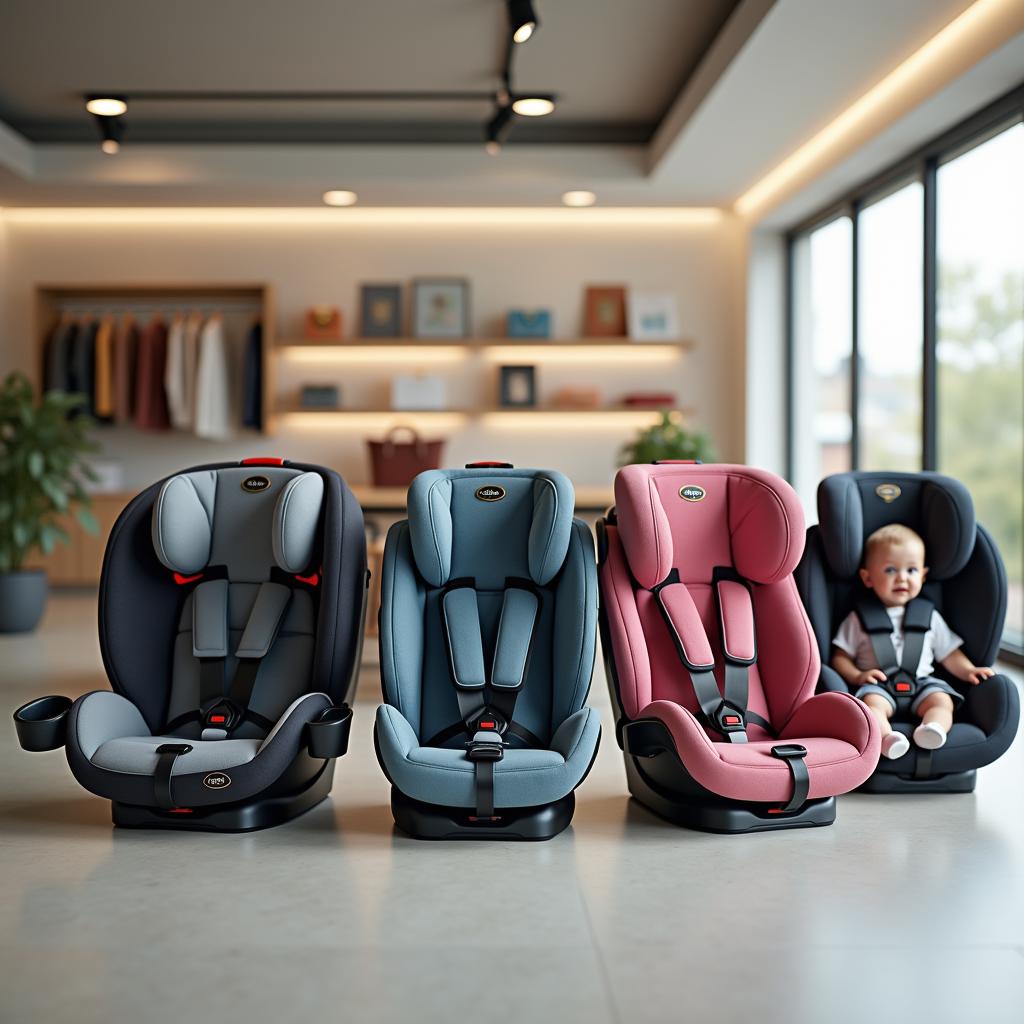The Ultimate Guide to Choosing the Perfect Car Seat for Your Child

Alright, parents, let’s talk about something super important: picking the right car seat for your little one! Seriously, this is one of those crucial choices you’ll make to keep them safe while hitting the road. With a million options blazing on the market, it’s essential to get a grip on the different types of car seats, safety regulations, and those nifty features that can amp up both safety and comfort. This guide is here to arm you with all the knowledge you need to snag the perfect car seat for your child and travel with peace of mind.
Content Overview
- The Importance of Car Seats
- Types of Car Seats
- Safety Regulations
- Installation and Use Tips
- Maximizing Comfort
- Common Mistakes Parents Make
- Frequently Asked Questions
The Importance of Car Seats
Check this out: car seats can cut the risk of death by a whopping 71% for infants and 54% for toddlers in passenger cars! That’s huge, right? This stat underscores just how vital it is to have the right child car seats in place. Safe travel isn’t just a parental concern; it’s actually a legal must in many states. Across the U.S., kiddos have to be strapped into a car seat until they hit a specific age, weight, or height. So, you see how crucial it is to ensure your child’s safety when you’re on the move?
Types of Car Seats
Now, let’s dive into the various types of car seats out there. Understanding the differences is key to making an informed decision. Car seats are mainly divided into three groups based on age, weight, and height. This knowledge can seriously boost your child’s safety and comfort levels.
Infant Car Seats (Group 0)
These bad boys are made for newborns and babies weighing up to 22 pounds (about 10 kg). The kicker? They’re always rear-facing, which gives your little one’s head and neck the best protection during any bumps in the road.
Convertible Car Seats (Group 1)
Convertible seats are like the Swiss army knife of car seats! They can be used both rear-facing and forward-facing, catering to kids from infancy all the way up to around 65 pounds (about 29 kg). This flexibility makes them a savvy choice for families with growing kiddos!
Booster Seats (Group 2 and 3)
Booster seats help lift your child so the seat belt fits just right across their body. These seats are typically for kids weighing between 40 to 100 pounds (around 18 to 45 kg). They’re a must-have for older kids who have outgrown their convertible seats but aren’t yet ready to rock adult seat belts.
Each type of car seat comes packed with features and adjustments to keep your child safe, so choosing one hinges on your child’s size, age, and the vehicle they’ll be riding in.
Safety Regulations
Let’s get real about safety regulations—they’ve changed quite a bit over the years, and now they are stricter than ever. In the U.S., car seats must go through rigorous testing to meet the safety standards put forth by the Federal Motor Vehicle Safety Standards.
Don’t forget, many states have laws stating kids must stay in some form of car seat until they hit a height of 4 feet 9 inches (about 145 cm), which generally happens between ages 8 and 12. So, staying up-to-date with local laws is crucial since they can differ quite a bit.
And just as a heads-up for those watching from across the pond, in the UK since September 2006, children under 12 or those shorter than 135 cm must use the right child seat while traveling. Trust me, these regulations are crafted to prevent injuries and fatalities, so it’s super important to stick to them!
Installation and Use Tips
Installing that car seat correctly is just as critical as choosing the right one. Believe it or not, almost 75% of car seats are installed incorrectly! So, here are some no-fail tips to help you nail that installation:
Read the Manual
Before you dive into installation, make sure you read both the manual for your car seat and your vehicle’s owner manual. Every model can have its own quirks—so don’t skip this step!
Use the Right Seatbelt or Connector
Make sure you’re using the right seat belt or the LATCH system (Lower Anchors and Tethers for Children) if your vehicle has it. Both methods can secure the car seat like a charm—just tighten it up according to the seat’s requirements, and you’re golden!
Check for Movement
Once you think you’ve got it set up, give that seat a shake! If it moves more than an inch side to side, it’s not snug enough. Adjust until it feels solid and secure.
And hey, for some extra peace of mind, take that car seat to a local inspection station or event. Lots of communities have free inspections run by certified technicians who can make sure you nailed the installation!
Maximizing Comfort
While safety is king, we’ve gotta think about your child’s comfort too. An uncomfortable kiddo can bring on all sorts of fussiness during travel. So, let’s get into some tips to ramp up their comfort:
Proper Padding
Make sure the seat offers good padding and adjustability as your child grows. Many quality car seats come with removable padding that you can tweak to fit your child perfectly.
Climate Control
If you live in a warm climate, keep an eye out for seats with breathable fabrics or cooling gel pads to keep your little one comfy on those hot days. And seriously, always check that your child isn’t wearing bulky clothes that can affect how the seat belt works!
Entertainment Options
For those long road trips, consider investing in rear-seat entertainment systems or organized travel bags for your child’s toys and snacks. It can make those longer journeys a lot more bearable and keep them happily distracted!
Common Mistakes Parents Make
No matter how great our intentions are, it’s easy to trip up when it comes to car seat use. Let’s highlight some common mistakes so you can steer clear of them:
Forward-Facing Too Soon
Way too many parents flip their little ones to a forward-facing seat before it’s safe. Aim to keep them rear-facing until they’ve hit the maximum weight or height limit for their seat—usually until at least 2 years old.
Neglecting to Secure Loose Items
Loose stuff in the car can turn dangerous during sudden stops or crashes. Always make sure to secure or clear out anything that could fly around and hurt your child or others in the vehicle.
Skipping the Booster Seat
It’s a bummer when parents think their child is ready for a regular seat belt too soon. Always check the height and weight requirements for booster seats and ensure your child meets them before moving on!
In the grand scheme of things, staying informed and being proactive about car seat use can make a huge difference in keeping your child safe while traveling.
Frequently Asked Questions
What is the safest type of car seat for infants?
The top choice for infants is a rear-facing infant car seat, built to protect their little head and neck in case of a collision.
When can a child transition to a booster seat?
A child can switch to a booster seat when they hit the weight minimum for their convertible car seat—typically around age 4—and when they outgrow the height limit for their forward-facing seat.
Are there age restrictions for using a car seat?
You bet! Regulations vary by state, but usually, kiddos need to ride in a car seat until they’re at least 8 years old or reach a height of 4 feet 9 inches.
How can I ensure my car seat is installed correctly?
The best way to confirm it’s installed right is to follow the manuals for the car seat and vehicle closely. And consider getting it checked out at a local inspection center for that extra peace of mind.
What is the LATCH system?
The LATCH system (Lower Anchors and Tethers for Children) is a game-changer designed to make car seat installation easier and more secure, without needing seat belts. It uses lower anchors and a top tether to keep the car seat locked in.
Choosing the right car seat is a big step toward keeping your child safe and comfy on the road. So whether you’re shopping at Mega Choice Bazaar or any other spot, make sure to mull over all the factors in this guide and check out the different options available. Your child’s safety deserves every bit of effort!









Leave a comment